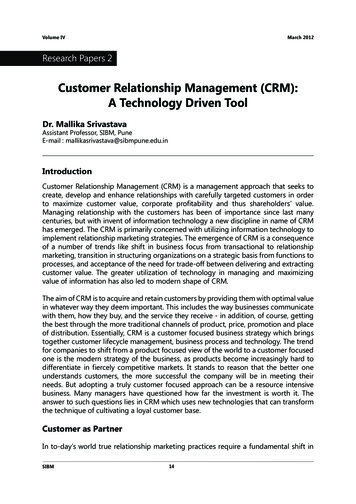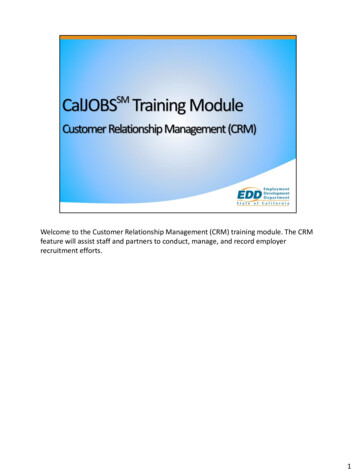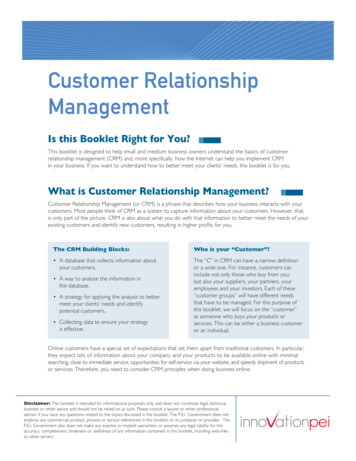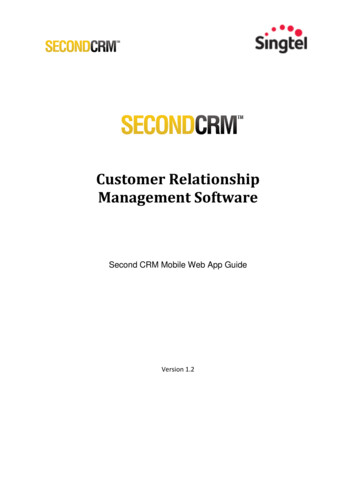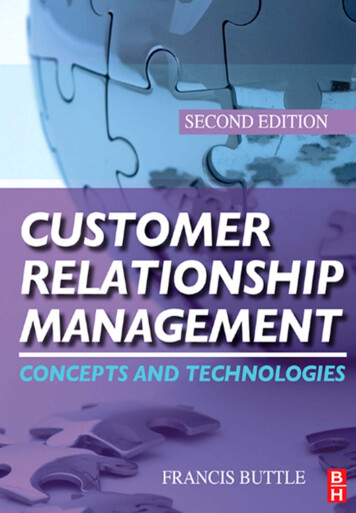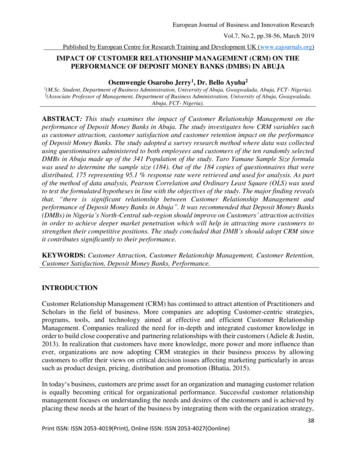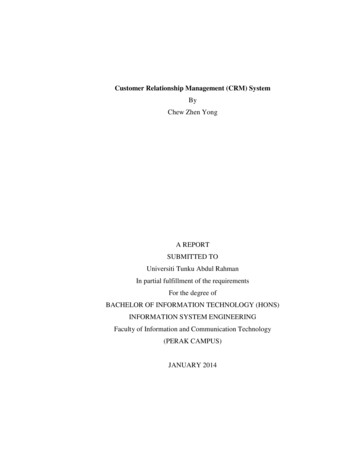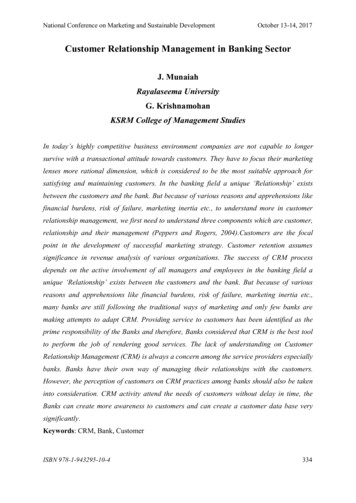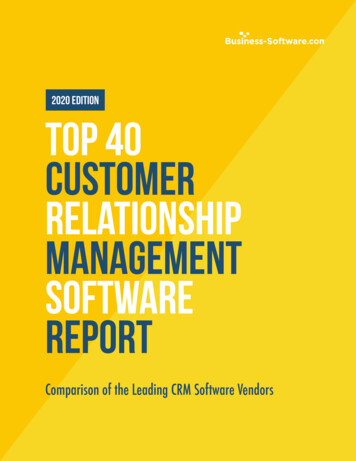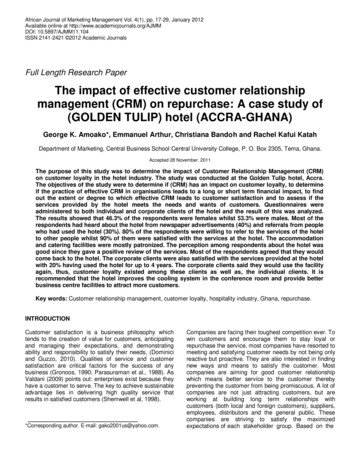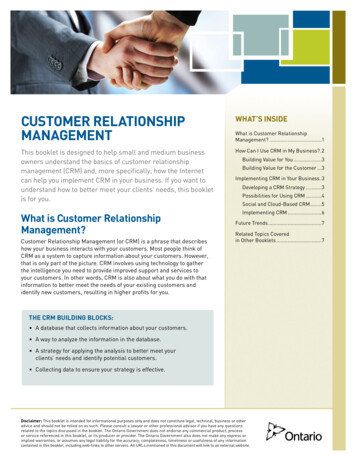
Transcription
CUSTOMER RELATIONSHIPMANAGEMENTWHAT’S INSIDEThis booklet is designed to help small and medium businessowners understand the basics of customer relationshipmanagement (CRM) and, more specifically, how the Internetcan help you implement CRM in your business. If you want tounderstand how to better meet your clients’ needs, this bookletis for you.How Can I Use CRM in My Business?.2What is Customer RelationshipManagement?Customer Relationship Management (or CRM) is a phrase that describeshow your business interacts with your customers. Most people think ofCRM as a system to capture information about your customers. However,that is only part of the picture. CRM involves using technology to gatherthe intelligence you need to provide improved support and services toyour customers. In other words, CRM is also about what you do with thatinformation to better meet the needs of your existing customers andidentify new customers, resulting in higher profits for you.What is Customer RelationshipManagement?.1Building Value for You.3Building Value for the Customer.3Implementing CRM in Your Business.3Developing a CRM Strategy.3Possibilities for Using CRM.4Social and Cloud-Based CRM.5Implementing CRM.6Future Trends.7Related Topics Coveredin Other Booklets.7THE CRM BUILDING BLOCKS: A database that collects information about your customers. A way to analyze the information in the database. A strategy for applying the analysis to better meet yourclients’ needs and identify potential customers. Collecting data to ensure your strategy is effective.Disclaimer: This booklet is intended for informational purposes only and does not constitute legal, technical, business or otheradvice and should not be relied on as such. Please consult a lawyer or other professional advisor if you have any questionsrelated to the topics discussed in the booklet. The Ontario Government does not endorse any commercial product, processor service referenced in this booklet, or its producer or provider. The Ontario Government also does not make any express orimplied warranties, or assumes any legal liability for the accuracy, completeness, timeliness or usefulness of any informationcontained in this booklet, including web-links to other servers. All URLs mentioned in this document will link to an external website.
2 You care about their needs, questions and concerns.WHO IS YOUR “CUSTOMER”?The “C” in CRM can have a narrow definition or awide one. For instance, customers can includenot only those who buy from you, but also yoursuppliers, your partners, your employees and yourinvestors. Each of these “customer groups” willhave different needs that have to be managed.For the purpose of this booklet, we will focus onthe “customer” as someone who buys your productsor services. This can be either a business customeror an individual.Online customers have a special set of expectations thatset them apart from traditional customers. In particular,they expect lots of information about your company andyour products to be available online with minimal searching,close to immediate service, opportunities for self-servicevia your website, speedy shipment of products, andafter-sales support. Therefore, you need to considerCRM principles when doing business online. You want to deliver services and productsthey need the most. You appreciate their business.CRM will also benefit your company by allowing you to: Develop superior services and products that meet yourcustomers’ identified needs. Enhance marketing towards the most profitablecustomers to improve your bottom line. Improve efficiency by providing support and services tocustomers online (through frequently asked questions,for example). Anticipate future business needs based on data onhistoric sale and service trends. Increase your customer base as you develop new waysto engage in business online.Benefits of CRMCRM is about making each and every customer feel likethey have a one-to-one relationship with you. Effective CRMgives you the opportunity to show your customers that:THE BOTTOM LINE:CRM seeks to answer two questions:1. Who are my customers?2. How can I serve them better? You know and recognize them. You understand them.How Can I Use CRM in My Business?The table below displays the types of information you can collect with a CRM system, along with the questionsthat the information can help answer.Type of InformationQuestionsCustomer profile Who are they? Are they a business or a person? Where are they located? If they are a business, how big are they? If they are a business, what do they do? Why do they need your product? How do they communicate with you? Do they have an account? How long have they been a customer?continued on next page
3Type of InformationQuestionsCustomer buying profile How often do they buy? When do they buy? Is there a pattern to their buying habits (e.g., seasonal)? How much do they buy at one time? Over time?Customer buying preferences What do they buy? Do they always buy the same thing? Why do they buy it?Customer service profile What kinds of problems/issues do they encounter? What is the current status of their issues? How many open tickets are there? How many cases have been resolved?Building Value for YouBy compiling this information and analyzing it, you canthen build a strategy with this information to: Maximize repeat business opportunities byanticipating your existing customers’ needs. Offer an online forum where customers can providereviews and feedback; this also allows you to hearabout problems as they emerge and to respond quickly. Offer free products to your best customers. Offer incentives for additional or future purchases. Identify your best customers. Identify potential customers.CUSTOMER LOYALTY Identify complementary products you cansell to your customers.By creating value for your customers, you will earntheir loyalty. An often-quoted statistic states that ittakes ten times the money and effort to attract anew customer than it does to retain anexisting one. Target marketing campaigns/materialsand promotions.Building Value for the CustomerOther ideas on how you can use this informationto increase your company’s perceived value to thecustomer include: Make ordering or buying easier through pre-filledorder forms and e-mail reminders. Tailor the shopping experience for your customersand allow self-service to reduce customer wait times. Develop an e-newsletter or blog with topics that wouldbe of interest to customers to earn their loyalty. Quickly share updates and respond to comments/feedback from customers through social mediachannels such as Twitter.Source: www.canadabusiness.caImplementing CRM inYour BusinessDeveloping a CRM StrategyDeveloping a CRM strategy is an investment of yourtime that will be beneficial over the long-term. Creatinga strategy allows you to set a direction for your CRMinitiatives and ensures that your investments are targetedto foster stronger relations with your customers.As a starting point for developing a CRM strategy, yourbusiness should identify its customer profile (e.g. theirneeds, their level of satisfaction, and what impacts their
4purchasing decisions). Through this process, you maybe able to identify a subset of your client base where youwould like to focus your efforts. Your CRM strategy shouldalso define the goals of your business’ engagement withcurrent and future customers to maximize sales, profitand long-term growth. You also need to assess yourcompany’s capabilities and whether it has the technology,human resources and skills to meet these goals.Gartner, an information technology research andadvisory company, released a report in 2010 called“Three Steps to Create a CRM Strategy”. It identifiesthese key areas for creating a successful CRM strategy.1. Set clear desired results for CRM, identify the stepsto achieve this vision, and monitor progress towardsthese goals.2. The CRM strategy should be incorporated into theentire business model and align with strategiesfrom other areas such as marketing and sales.3. The CRM strategy should include these eight aspects:vision, strategy, customer experience, organizationalcollaboration, processes, customer information,technology, and metrics.Source: CRM-Strategy-66669.aspxPossibilities for Using CRMThere is a continuum of CRM from the most simple (a spreadsheet or database containing information about yourcustomers—referred to as a contact management system) to the most complex (online applications automaticallylinked with your back-end systems). An integrated CRM system can include the following features:FeatureBenefits A central database that is accessible by all employeesto view and update customer data. Improved customer service, loyalty and retention. Analysis of customer data including customer Customized marketing or sales campaigns.segmentation and segmentation of potential customers. Improved campaign targeting. Customer self-service where the customers canself-order and help themselves using web-based,password access. Reduced order entry cost and customer service cost. Identifying and tracking potential customers. Wider customer base. More focused prospect tracking. Reports generated with up-to-date information,including revenue forecasting and trend analysis. Better and more timely decision making.
5CRM Delivery Model OptionsSo what are your options in terms of implementing CRM at your business? You have two main options:1) a CRM package installed on your premises, or 2) a hosted CRM solution. These two options, along withtheir relative pros and cons are discussed below.OptionProsConsOn-premise CRMThere are many CRM systems thatare available for purchase off-theshelf. These can then be tailored toyour needs. Companies such asSiebel, Oracle, SAP, and Chordiantare well known in this area. Can be tailored to your business More expensive in the short run(costs can vary from severalthousand to several million dollars) Most companies offer flexiblepackages that are suitable forsmall and medium businesses Can take a long time (months oreven years) to implement fullyHosted CRMWeb-based applications for CRMwith no software to download. In thiscase, the CRM system resides onlineand you rent the service on a monthlybasis. Examples include, SageSoftware, Microsoft Dynamics,Entellium, Clear C2, SAP,NetSuite, VanillaSoft Less expensive in the short run(monthly fees run from about 65 to 150) Cannot be integrated with otherback office systems Can be integrated with yourother systems Appropriate for businesses withstandard CRM needs, and little orno internal IT support You are allowing someone else tocontrol your customer informationand data Can be implemented quickly(often within a few months)Social and Cloud-Based CRMIn addition to the two main system-based options forimplementing what could be called traditional CRM asdescribed above, there is a new approach to CRM beingused with increasing frequency. Social CRM is a type ofCRM that uses social media tools and services to engageand attract customers. As well, Social CRM is also usedto monitor what is being said about your company orproduct in the social media realm. Companies suchas Vitrue, HootSuite, and HubSpot offer web-basedapplications to help you effectively publish content,monitor responses, and track brand mentions onsocial media sites.Social CRM can be quite advantageous to your businesssince you can increase your reach and have immediateengagement with your customers. As well, it can offeryou another way to get feedback from your customersregarding products, services, and your brand. Anotheradvantage of this approach is that it can be implementedquickly. On the other hand, you need to align your SocialCRM with your overall marketing strategy and brandmanagement. As well, you need to keep in mind thatyou will have limited control over any negative feedbackposted about your brand or product/service. To implementSocial CRM, you will also have to ensure that youremployees have social media knowledge or training.At the same time, there is also cloud-based CRM. Cloudcomputing services are becoming increasingly popularand offer a cost-effective way for businesses to gathercustomer data. Cloud computing is really any form ofshared computing service that you access through theInternet (e.g. Gmail, Dropbox). Several CRM cloud-basedsystems are already available that allow businesses toaccess, organize, and analyze information about theircustomers and sales online. Cloud-hosted CRM softwarealso facilitates data integration from other sources sincemany other services are also cloud-based.
6Implementing CRMImplementing a CRM system is more than installing asoftware package. All functional areas of your businessneed to be engaged—human resources, marketing,sales, IT, product development, etc.TIP: CRM is a business strategy, not a technology.For CRM to succeed in your company, first developyour CRM strategy, and then choose the besttechnology to support it.You will need to ensure all your employees understandCRM and what it means in your business. This can bedone through formal training or information meetings.Developing a written CRM strategy is another good wayto communicate with your employees.How much data is the right amount of data to collect?Once you get started collecting data about your customers,it’s sometimes hard to know when to stop. If you do collecta lot of data, there are two things to consider:1. Do your current systems have the capacity to hold andmanage it?2. Do you really need to store every piece of informationyou collect (e.g., maybe you just need it one time)?Smooth implementation o
Web-based applications for CRM with no software to download. In this case, the CRM system resides online and you rent the service on a monthly basis. Examples include, Sage Software, Microsoft Dynamics, Entellium, Clear C2, SAP, NetSuite, VanillaSoft Less expensive in the short run (monthly fees run from about : 65 to 150) Appropriate for businesses with standard CRM needs, and .
